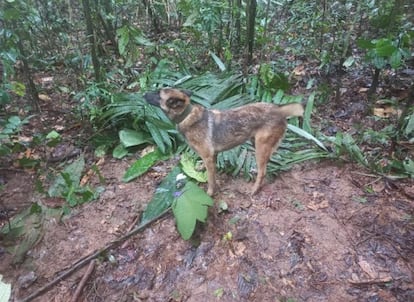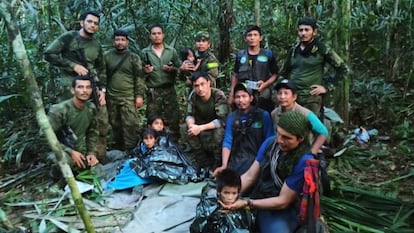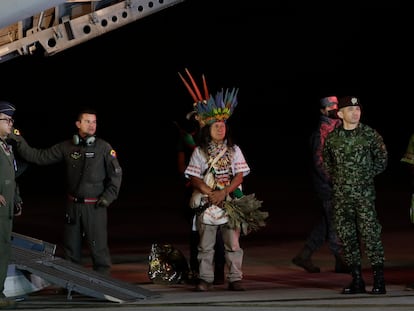How four children survived 40 days in the Amazon on their own: Lesly’s mission and the secrets of the jungle
The eldest of the siblings looked after the others, and kept them alive thanks to what she had learned from growing up in the rainforest
The plane crashed to the ground after gliding over the trees. The mother’s body was inside the aircraft, along with that of the pilot and a family friend. All three had died upon impact. It was at that moment that 13-year-old Lesly suddenly realized that she and her three little siblings had survived a plane crash in the middle of the Colombian jungle. From that moment on, alone, and without anyone’s help, she had a single purpose: to keep them alive in the inhospitable and dangerous Amazon rainforest. When they were rescued, 40 days later, malnourished and frightened, the children wanted to play and read.
The four children lived with their parents in Araracuara, a town in the heart of the Amazon jungle, where in the 1930s a Colombian president ordered the construction of a prison to lock up the most dangerous criminals. Lock up is a figure of speech: in reality, the prisoners lived outdoors, in the middle of swampy and inhospitable terrain. Anyone entertaining the idea of escape by entering the jungle was signing their own death warrant. The following generations that were born there, many descendants of convicts, learned to live among snakes, jaguars and poisonous plants.
Lesly, as a daughter of that terrain, is familiar with the secrets of the jungle. According to her uncle, she knows how to orientate herself by the rays of the sun that filter through the trees, and to recognize passable paths, broken branches and edible mushrooms. A city dweller would struggle to survive in such terrain but the people of the indigenous communities move easily in the forest and can walk 19 miles a day without hiking shoes. Lesly had grown up with those teachings — lessons that would end up saving her and her siblings’ lives.

But she still had to get on that plane, a Cessna 206, registration HK 2803, piloted by Hernán Murcia, who had previously been a taxi driver. It was May 1. The mother, Magdalena Mucutuy, and her four children were going to meet the father, Manuel Ranoque. He was governor of the nearest indigenous reservation, but had fled from Araracuara after being threatened by guerrillas. He hoped to start a new life with his whole family in Bogotá, Colombia’s capital.
The flight left from their town and was scheduled to arrive in San José del Guaviare, the nearest departmental capital. The journey involves flying over a large part of the jungle. Halfway over the Apaporis River, the pilot reported an engine failure. It was the last communication he had with the control tower. After that, the plane began to lose altitude. Based on the path that the plane followed, it is believed that the pilot tried to land in the river, but he did not have time and so tried to land on top of the trees. This did little to lessen the blow of the impact and the plane ended up crashing to the ground.
For a reason that so far no one has been able to explain, the three adults did not survive the crash — although after they were found the children reported their mother was not killed instantly — while the four minors escaped with barely any injuries. The authorities that reported the missing flight assumed that there were no survivors. It was not until 16 days later that a group of indigenous people found the plane with the three bodies inside. Where were the children? A bottle, a half-eaten apple, a hair tie and some diapers were found, indicating that they were alive. But where?

Lesly, Soleiny (nine), Tien Noriel (four) and Cristin Neriman (11 months) began a journey into the jungle that would defy all expectations. Lesly led her siblings and kept them safe and sound. It is now known that they survived by eating what they could scavenge and, later, on the food from kits that rescuers dropped from the sky. More than 100 members of the Colombian special forces and 70 indigenous people were in charge of the search for the missing children, who were wandering alone through the largest rainforest on the planet.
On the journey, the children ran into a dog that stayed with them and kept them company for a long time. But one day, the jungle swallowed him up, and they never heard from him again: their best friend was lost. In the jungle, it is always night, as hardly any light penetrates the thick foliage. It is so dark that it’s hard to see more than 20 meters ahead. If someone strays further than that distance, they can be lost forever. The children must have stayed close together. Lesly, according to a military source, was the one who carried the baby most of the time.

The children had no way of knowing, but finding them had become a matter of honor for the president of Colombia. Days after the appearance of the plane, Gustavo Petro tweeted that they had been found alive. The news went viral in minutes. With the passing of the hours, however, the military did not confirm the president’s post. It later transpired that an official had been carried away by rumors in an indigenous community and assumed that the children had been found. Petro had to delete the message, and was criticized for not showing more caution. In response, Petro ordered the military to do everything possible to find them, arguing it was a matter of national priority.
At that point, the children had been missing for almost 20 days. The commander in charge of the search, Pedro Sánchez, said that if they had not been indigenous children, there would have been very little chance of finding them alive. He had faith in Lesly. The search patrols walked hundreds of miles, weaving a spider web on the map with their steps. But they could not find the children. Time was running out.
The search was taking so long that the country practically forgot about them. The government became entangled in an illegal wiretapping scandal and rumors of irregular financing, and almost everyone lost interest. But Commander Sánchez didn’t care about all that. He always picked up the phone with the same urgency: “Until we find them, we’re not going to leave.” He believed that if they were dead, the search teams would have found their bodies. They hadn’t done so, he said, because they were moving targets. Targets with birthdays: while lost in the jungle, the baby turned one and the four-year-old turned five. It’s not known if they were aware of their birthdays, and if they did anything to celebrate. Days and nights in the jungle are a uniform mass, where the hands of the clock cease to have any meaning.
The soldiers were supported by indigenous communities. Without them, the search would have been impossible. Before entering the jungle, the indigenous people prayed as a way of asking mother nature for permission to enter. They have a series of beliefs and rituals that are difficult for outsiders to understand. For them, the jungle is a living entity with rationality and will. The children’s grandmother said that it was nature that stopped them leaving. Spiritual beliefs are very strong. They also believed that the nomadic tribes of the area had applied ancestral forces to stop authorities from finding the children, because they wanted the siblings to live with them.

Indeed, Petro feared that one of the isolated communities may have found the children and taken them in as their own. Anything was better than thinking that they were dead. After 40 days in the jungle, the military and indigenous search teams found the four. They were malnourished and tired, but their lives were not in danger. Lesly had succeeded in her goal. For Colombia, she has turned into something of a legend.
The soldiers airlifted the children out of the jungle by helicopter and took them to a hospital in Bogotá, where they will remain for two or three weeks. In the hospital, they are already getting bored. The five-year-old, Tien Noriel, wants to take out his tubes and go for a walk, according to official Astrid Cáceres. The children told her that after their 40-day odyssey, they just want to play and read. They are just kids, after all.
Sign up for our weekly newsletter to get more English-language news coverage from EL PAÍS USA Edition
Tu suscripción se está usando en otro dispositivo
¿Quieres añadir otro usuario a tu suscripción?
Si continúas leyendo en este dispositivo, no se podrá leer en el otro.
FlechaTu suscripción se está usando en otro dispositivo y solo puedes acceder a EL PAÍS desde un dispositivo a la vez.
Si quieres compartir tu cuenta, cambia tu suscripción a la modalidad Premium, así podrás añadir otro usuario. Cada uno accederá con su propia cuenta de email, lo que os permitirá personalizar vuestra experiencia en EL PAÍS.
¿Tienes una suscripción de empresa? Accede aquí para contratar más cuentas.
En el caso de no saber quién está usando tu cuenta, te recomendamos cambiar tu contraseña aquí.
Si decides continuar compartiendo tu cuenta, este mensaje se mostrará en tu dispositivo y en el de la otra persona que está usando tu cuenta de forma indefinida, afectando a tu experiencia de lectura. Puedes consultar aquí los términos y condiciones de la suscripción digital.
More information
Archived In
Últimas noticias
Millennia-old Yuracaré language resists extinction through 900 speakers and a new dictionary
Susan Boyle prepares a comeback just as Timothée Chalamet sings her praises
Trump suspends green card visa lottery after shooting at Brown University
When things get out of hand at the lab: Hundreds of accidents expose the ‘catastrophic’ risk of dangerous pathogen leaks
Most viewed
- Christian Louboutin: ‘Young people don’t want to be like their parents. And if their parents wear sneakers, they’re going to look for something else’
- Cartels in Mexico take a leap forward with narco-drones: ‘It is criminal groups that are leading the innovation race’
- Liset Menéndez de la Prida, neuroscientist: ‘It’s not normal to constantly seek pleasure; it’s important to be bored, to be calm’
- ‘El Limones’ and the growing union disguise of Mexican organized crime
- The low-cost creative revolution: How technology is making art accessible to everyone












































